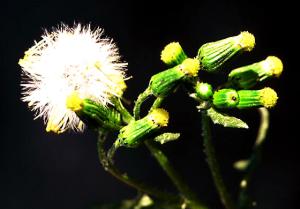CONTENTS
Registered Herbicides
[Return to weed
Identification]
[Return to Weed
Management]
[Home] |
|

General Description:
- simple or branched upright growth, 6-18 inches tall.
- foilage is generally smooth but may have light
pubescence.
- alternate leaves are irregularly and deeply lobed -
upper leaves attached to stem directly.
- basal leaves have a purple color on underside.
- yellow disk flowers are numerous.
- fruit is ridged, slender and slightly pubescent.
- young plants appear as rosettes.
- small taproot with secondary fibrous root.
- contains the same pyrrolididine alkaloids found in
tansy ragwort and may cause liver damage in horses and cattle (though not as toxic as
tansy).
- biotypes have evoloved which are resistant to triazine
and dinitroaniline herbicides.
Life cycle: winter or summer
annual, sometimes acts as a biennial
- reproduces by seed.
- germinates early spring - late fall.
- may produce 3-4 generations in one season.
- seedlings: cotyledons and young leaves are purple on
underside
- flowers April - Ocotober.
- seed can mature in opened flowers even after plants
have been killed.
Impact on Yield:
- Although groundsel is not a strong competitor, heavy
infestations have the potential to reduce mint yields. In one study, a medium infestation
of groundsel caused a loss of 12 lbs per acre of peppermint oil (Ian Heap).
Habitat/Crops associated with:
- prefers cool and wet envirnonment - and nutrient rich
soil.
- nusery stock, landscape, vineyards.
- mint, wheat (west of the Cascades).
Herbicide Control Notes:
- Resistance to Buctril common in some regions. The
combination of Gramoxone and Goal is very effective during the dormant season. Stinger
most effective in fall or tank-mixed with Buctril or Basagran in spring.
|